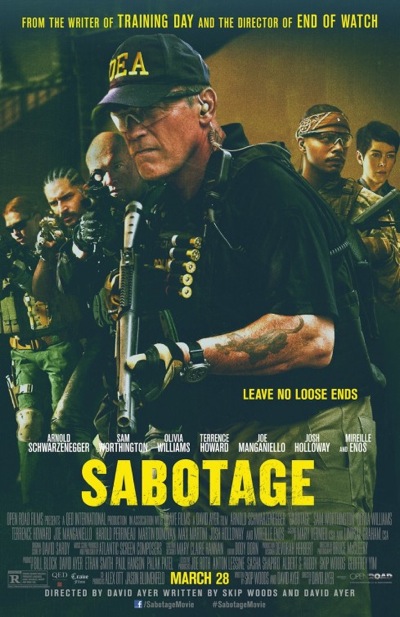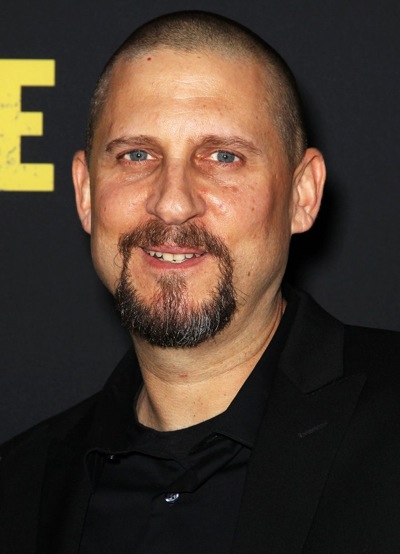
David Ayer's exploration of law enforcement's seedy underbelly turns positively toxic in SABOTAGE, an Agatha Christie-inspired yarn in which members of an elite and thoroughly corrupt DEA task force get picked off one-by-one in spectacularly gruesome fashion. It's pure pulp: a frenetically shot-and-paced actioner with a slasher film structure. In many ways, it's a modern-day Cannon movie, recalling in particular the anti-human early-'80s works of Charles Bronson and J. Lee Thompson. The only decent characters in this movie are dead before the opening credits; everyone, from Arnold Schwarzenegger on down, behaves ruthlessly and amorally.
But it's morbid fun to wade into the morass now and then, and Ayer has done so with an unapologetic zeal. His hook is Schwarzenegger, who's tatted up and worn down as John "Breacher" Wharton, the commander of the film's ill-fated DEA unit. Having lost his wife and child to a vicious Mexican drug cartel, Breacher is simply in it for ill-gotten gains skimmed off the top of big-time drug busts; he was once out for revenge, but that fire seems to have been extinguished. All he's got now is his team, a motley collection of scumbags and maniacs who get off on the adrenaline high of gunplay; they're a weirdly loving family, but they turn on each other the minute they realize they're being hunted.
For Ayer, the challenge of SABOTAGE was integrating a Hollywood icon like Schwarzenegger into what is ostensibly an ensemble film. For the most part, he pulls it off. Though screen-time certainly tilts in Schwarzenegger's favor, he feels as helpless as his subordinates; it's a bit like PREDATOR in that regard, which gives the film a bit of a nostalgic charge. When I chatted with Ayer at the film's Los Angeles press day, we discussed the ensemble nature of the narrative and how he transformed these actors into SWAT-trained badasses. We also talked about the film's remarkably perilous stunt work, and how he pulled off one of the most violent car wrecks I've seen in some time.

Jeremy Smith: How are you holding up?
David Ayer: This is fun. It's nice when people don't hate the movie. (Laughs)
Jeremy: I can imagine that's a plus. Compared to the other films you've directed, this one is really down-and-dirty pulp. You share a writing credit on this with Skip Woods. When the project came to you, what kind of shape was it in and what did you add to it?
Ayer: Skip had this interesting script. What drew me to it was that it had this high-speed, badass DEA undercover/SWAT team, and then they start getting hunted. I was like, "These guys are monsters. What kind of monster does it take to hunt a monster?" That was the creative hook for me. Then Arnold got involved, and it was an opportunity to take someone who is a freaking cinema legend, iconic, and try to get him in a different space. Normally, he's playing very black-and-white characters in a more poppy, action-y execution. I wanted him to feel like someone you could pass on the freeway on the way to work, or someone who could live in your neighborhood - someone who's lived a life, and has experienced consequences and pain and all of that neat stuff we all go through. Also to see him in an ensemble cast, to surround him with these maniacs and have him be the beastmaster, to feel him as the father and coach and mentor of this insane family... it works. We haven't really seen him like this. It's fun to put him in a brutal, nasty, dirty world.
Jeremy: He's such an iconic movie star that it's hard not to view him in that context. I just asked him if he's thought about tweaking his iconography in the way Clint Eastwood has done later in his career, and he basically said, "No, I just wasn't being offered these roles twenty years ago." Were you thinking of him in that way?
Ayer: I wanted to see him evolve. I'm such a big fan of his, and as a director it's really challenging to reinvent someone that you know so well. That was the challenge, and he was really willing to be different and to try a character that was different on paper. He was also willing to do a lot of training and prep and exercise - start from zero with no assumptions and just build up these skills. It's nice to see Arnold in these action scenes working in tandem as part of this tactical team flowing and clearing rooms, and having this great chemistry with all of these guys. They're conflicted and there are definitely shades of grey, but it comes across as a family.
Jeremy: An incredibly unruly family. I know a lot of these actors from other films, but here they disappear into their roles and make for a believable unit. They're exactly as I expect these kinds of people to be, which is...
Ayer: Fucking insane.
Jeremy: Right. What did it take to get them there?
Ayer: A lot of it just has to do with the prep time and training, giving them the real-world skills so you can send them through a door and they know how to cover each other and cover sectors and clear corners; they can then put that on autopilot and focus on bringing the character out and doing it as these characters. It's a lot of big personalities and big guys in this movie - literally. They're really competitive. I made the mistake of doing airsoft with these guys, and I got lit up so bad. But it's the fun of the competition. They're sparring and fighting, and I think all of the physical work brings out something different with actors. And changing their looks. I've had people tell me they couldn't recognize Sam Worthington. It's a combination of leading them down a good path, and listening to their ideas and letting them create these characters and live in their skin.
Jeremy: We hear a lot about making films that are throwbacks to the 1970s, at least in terms of moral ambiguity, and you're definitely doing that here. But it's one thing to say it, and quite another to pull it off. How do you deal with those expectations?
Ayer: Getting ahead of anyone's expectations is really tough. This movie is almost a genre mash-up. At its core, it's an action movie; there's a ton of freaking action. It's just a beast in that regard. But it's also a whodunit. It's a thriller and a mystery and a film noir, and it's executed in my style, which is about trying to create as much reality as possible. There are bits where it's heightened, but to keep everything movie and keep it fun and then to have this brotherhood-sisterhood element of these characters... that's how I think this is different. That's how you can get ahead of expectations a little bit. People are going to go into the theater expecting a certain kind of movie, but a lot more is going on than that. It's pretty robust.
Jeremy: A colleague called it an Agatha Christie action movie. TEN LITTLE DEA AGENTS.
Ayer: (Laughs) TEN LITTLE DEA AGENTS GET WHACKED. Don't mess with the cartel.
Jeremy: Absolutely. There's also an insane car wreck in this film.
Ayer: Yes.
Jeremy: What went into the shooting of that scene? It floored me. You know a wreck is good when there's a collective "Oh shit" from the audience.
Ayer: It's brutal. My special effects guys created this air-based ram, and it accelerates the car for the stunt gag from zero to forty-five miles-per-hour inside of thirty feet of travel. We had to clear everybody off the street because the impact is so bad it'll throw shrapnel for like a block. It's insane. So you have PAs running around yelling "Everybody clear!" We were shooting in downtown Atlanta on a work day, so they were getting lookie-loos off the street. It was amazing. They fired the ram, and the car's going so fast it's skidding the tires along; it can't turn it's moving so fast. That was one of the more complicated stunts I've done, but it worked really well. The chase came out really well.
Jeremy: Thinking about how your career has gone, with films like TRAINING DAY, HARSH TIMES, END OF WATCH and this, you've really carved out a niche with crime movies. You're so good at it.
Ayer: I like doing this, but I've also got a World War II movie in the can with Brad Pitt. We shot in London, and I'm editing that right now. I'm actually about to leave to go to the editing room and work on it. (Laughs) In a lot of ways, it's postmodern, but it's also very traditional in execution. It was really exciting for me to test myself and grow as a director, and also try my hand at world creation. Everything you see, you have to make it or track it down. Then to work with a guy like Brad is a freaking honor. He's just a good dude.
SABOTAGE hits theaters on March 28th. Grab a couple of beers and enjoy.
Faithfully submitted,
Jeremy Smith
